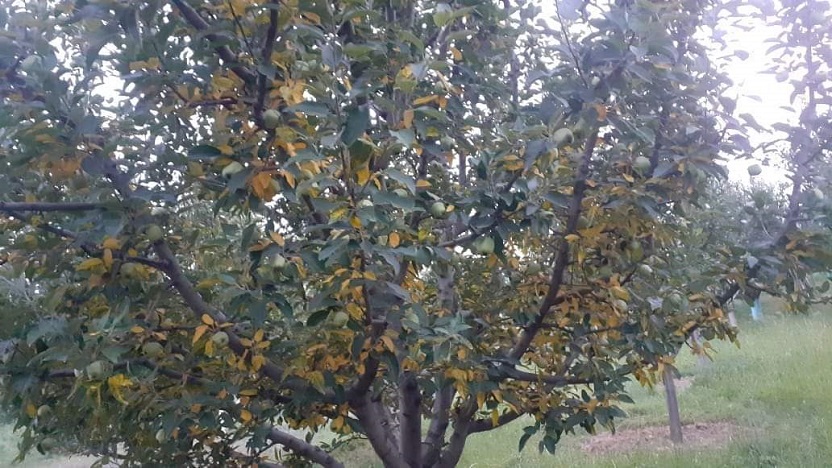
Srinagar- A new report by Indian Council of Agricultural Research (ICAR) has painted a grim image of the damage to the crops that happened in Jammu & Kashmir due to the scorching heat wave in the months of March and April.
The abnormal increase in maximum and minimum temperatures in the two months had viciously impacted crops, fruit, vegetable and animals in J&K, besides coinciding with grain filling and development stage of wheat, yellowing and shriveling of grain, forced maturity, resulting in reduction of yields up to 15-25%.
These figures appeared in ICAR’s report titled Heat Wave 2022: Causes, Impacts, and Way Forward for Indian Agriculture, stating that high temperatures caused significant damage to vegetables especially in tomato, cole crops and cucurbits.
The report also stated that a loss of appetite and higher body temperature was observed in milch animals which led to reduction of milk yield up to 15%. The extreme temperatures resulted in a drop in egg production and increased broiler mortality.
Extreme temperatures and heatwaves in several districts of Jammu and Kashmir resulted in poor vegetative growth, reduction of plant canopy, severe flower and fruit drop in several vegetable crops, early drying of cucumber, bitter gourd, cracking and scalding in tomato, caused reduction of fruit size and weight loss by 40 to 50%.
“Heat waves also led to reduction of cucumber and bitter gourd yield by 30 to 50%, and more than 40% in tomato compared to normal situation in Kathua and Bandipora districts of Jammu and Kashmir,” the report noted.
The hot weather, the report observed, increased the body temperature of livestock and milch animals by 0.5 to 3.5°C. Increase in temperature led to increase of water intake and loss of appetite in milch animals resulting in reduction in milk yield in Kathua district of Jammu and Kashmir.
Pertinently, the earth’s average temperature has been rising since the late 1970s. However, the year 2021 has broken the historical record of the global climate in many ways. The average global temperature across land and ocean surface areas in 2021 was 1.12°C higher than the twentieth-century average.
In J&K also, heat waves are becoming extremely intense and frequent leading to losses in agricultural productivity. The Sixth Assessment Report of the IPCC has also reiterated that Climate change is real and its impact is being felt throughout the globe.
In 2019, experts predicted that the irrigated rice, wheat and mustard production in J&K may be reduced by 6%, 4% and 4%, respectively. The deficit in food production in the Kashmir region had reached 40 % in 2019, while the deficit was 30% in vegetable production and 69 % in oilseed production, putting food security at a greater risk.
As per ICAR, several districts of J&K have been experiencing heat waves for more than five days for the past few years. As per the data, from 2011-2019, Kupwara’s average days of heatwave per year was 17.33, Bandipora 17.11, Baramulla 17.11, Ganderbal 17.11, Srinagar 17.11, Northern Areas 15.67, Badgam 15.56, Pulwama 15.56, Kishtwar 14.11, Anantnag 13.78 and Kargil 11.56.
The report also said that the heatwaves in 2022 were the deadliest as it started very early and extended for a longer period this year. During 2022, from 4th week of February to 3rd week of May, it was observed that unusually the winter rains have missed in the Jammu & Kashmir and the rainfall deviations have almost reached -100% from March 17-23 onwards till 20-26 April 2022, the report stated.
“Later, a slight increase in rainfall was observed but still deficient conditions of rainfall prevailed with rainfall deviation ranging from -62 to -100% was recorded during May 12 to 18. This triggered dryness in the environment and flow of hot desert winds caused the maximum temperatures to reach heat wave conditions,” the report observed.
As per the report, weekly temperature deviation maps of meteorological subdivisions Jammu & Kashmir, Himachal Pradesh, Uttarakhand, Punjab, Haryana-Chandigarh-Delhi, West Uttar Pradesh, West Rajasthan, East Rajasthan, West Madhya Pradesh and East Madhya Pradesh were prepared from 3 March to 25 May 2022 and Higher temperatures were observed in almost all the subdivisions from 3-9 March to 12-18 May.
“Maximum deviation in temperature was observed during the 7-13 April in Uttarakhand, Himachal Pradesh (9.8 degree celsius), Jammu Kashmir (9.1 degree celsius), Haryana, Chandigarh & Delhi (9.0 degree celsius) and Punjab (8.0 degree celsius),” the report said.
Follow this link to join our WhatsApp group: Join Now
Be Part of Quality Journalism |
Quality journalism takes a lot of time, money and hard work to produce and despite all the hardships we still do it. Our reporters and editors are working overtime in Kashmir and beyond to cover what you care about, break big stories, and expose injustices that can change lives. Today more people are reading Kashmir Observer than ever, but only a handful are paying while advertising revenues are falling fast. |
| ACT NOW |
| MONTHLY | Rs 100 | |
| YEARLY | Rs 1000 | |
| LIFETIME | Rs 10000 | |












